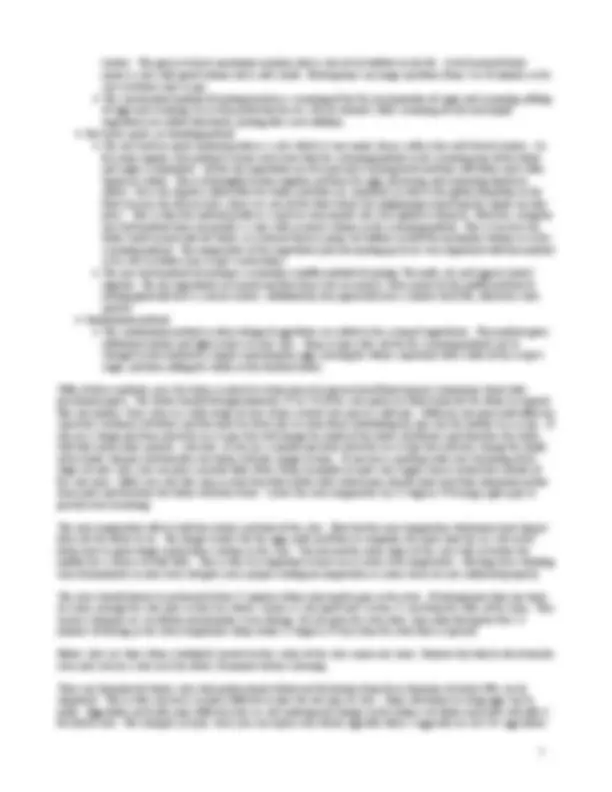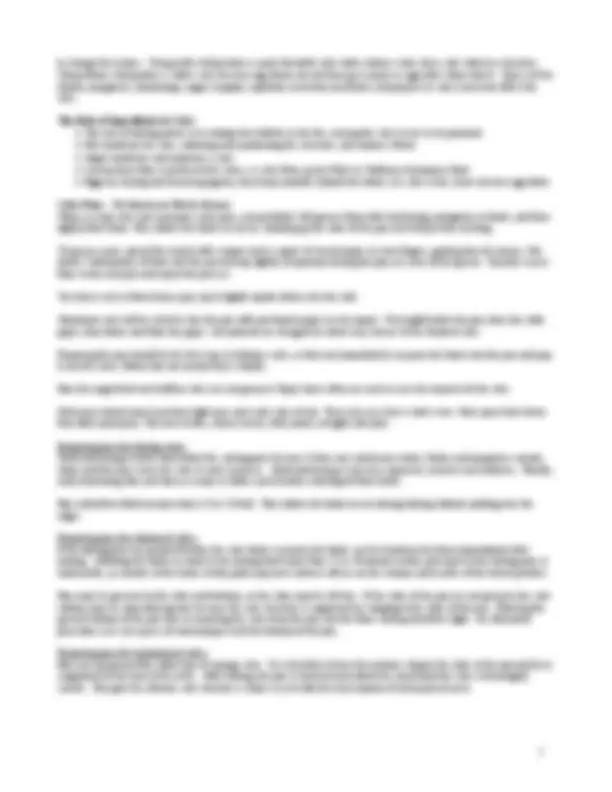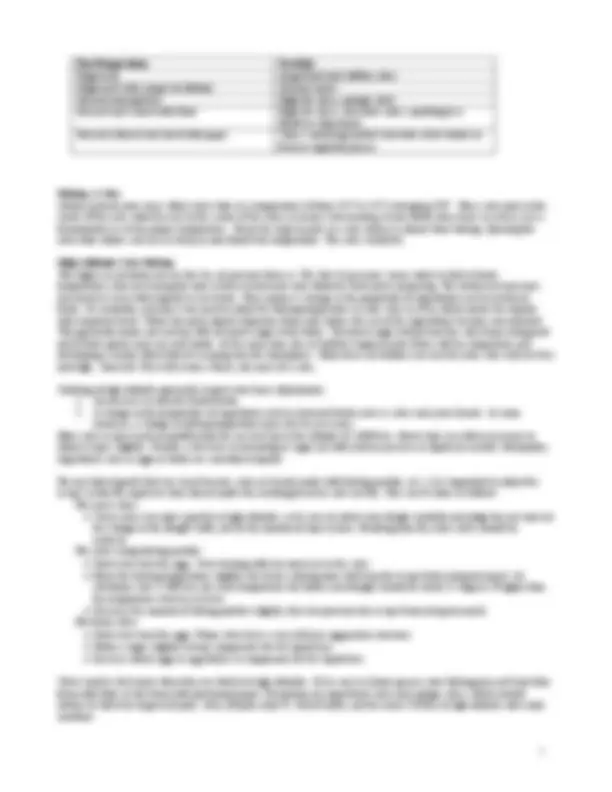





Study with the several resources on Docsity

Earn points by helping other students or get them with a premium plan


Prepare for your exams
Study with the several resources on Docsity

Earn points to download
Earn points by helping other students or get them with a premium plan
Community
Ask the community for help and clear up your study doubts
Discover the best universities in your country according to Docsity users
Free resources
Download our free guides on studying techniques, anxiety management strategies, and thesis advice from Docsity tutors
Material Type: Notes; Professor: Wright; Class: Culinary Arts; Subject: Nutrition and Food Science; University: Southern Utah University; Term: Unknown 1989;
Typology: Study notes
1 / 7

This page cannot be seen from the preview
Don't miss anything!




Cakes
There are two types of raised cakes: (1) foam (unshortened) cakes and (2) buttered (shortened) cakes ∑ Foam cakes ∑ Foam cakes have a high proportion of eggs to flour. They are leavened solely by the air beaten into whole eggs or egg whites. They contain very little, if any, fat and have a spongy texture. ∑ This is a category of cakes that are made with lots of stiffly beaten egg whites, which makes them light and airy. ∑ An optimum foam cake is fine, even textured. It is leavened by steam. ∑ The three categories of foam cakes are: ∑ Those that contain no fat ∑ Angel food cakes ∑ Meringues ∑ Dacuoises ∑ Those where the only fat is from egg yolks ∑ Sponge cakes ∑ Some biscuits ∑ Those that contain fat (butter, shortening) plus egg yolks ∑ Genoises ∑ Chiffons ∑ Two methods for producing foam cakes: ∑ Separating egg method: ∑ Sponge cake A light and airy cake that contains three basic ingredients: roomt emperature eggs, sugar, and flour and is leavened solely by the air beaten into the eggs. A basic sponge cake is made by beating the egg yolks and sugar until thick and lemon colored (when beaters are raised the mixture will form a ribbon as it falls back into the bowl) and then stiffly beaten egg whites (with a little sugar) are folded in. Contains no fat. A very versatile cake that can be flavored with extracts, nuts, citrus zests, liqueurs and can be baked in round cake pans or else a sheet pan. Can be eaten plain or filled with whipped cream, buttercream, jam or preserves, fruit, fruit purees, nuts, chocolate, etc. ∑ Angel food cake Sometimes referred to as Angel Cake and because of its airy lightness is said to be the "food of the angels". This cake has no egg yolks, fat, or artificial leavening agent so it relies totally on stiffly beaten egg whites for leavening. Its sole ingredients are egg whites, cream of tartar, sugar, flour, salt and flavoring (such as extracts). Angel Food Cake has the highest sugar content of all the sponge cakes and this added sugar is needed to support and stabilize the whipped egg whites. Because the egg whites give the cake its volume and structure care must be taken when adding them to the dry ingredients so they do not deflate. Traditionally baked in a rings haped tube pan it is placed upside down to cool to prevent it from falling and sticking to the pan. Usually served plain or with fresh fruit, fruit purees, and/or whipped cream. A moist, fluffy, feather light, delicate cake that is fat and cholesterol free. ∑ Meringue Simply a beaten mixture of egg whites and sugar (sometimes with cream of tartar), that are baked in a slow oven to produce a delicately crisp, white confection that seems to literally melt in your mouth. There are two types of meringue; soft and hard. The difference between the two is the amount of sugar added to the egg whites. Soft meringue is made with only a small amount of sugar. The whites and sugar are beaten only to the soft peak stage and is then used as a topping for pies and cakes, puddings, mousses, and the famous Baked Alaska. The meringue is baked until the peaks are browned and the valleys are lightly browned. ∑ Whole egg method ∑ Genoise ( Pronunciation: zhaneW AHZ ) Named after its place of origin, Genoa Italy, it is a type of light and airy spongel ike cake. Different from a sponge cake in that the eggs are beaten whole and a small amount of melted butter is added. This makes it more tender and flavorful but is less sweet than a regular sponge cake. Whole eggs and granulated white sugar are warmed over a water bath and then beaten until very thick. Flour, and sometimes cornstarch, are first folded in and then melted butter (usually clarified butter). Can be flavored with extracts, ground almonds, citrus zests, or liqueurs. The genoise is leavened solely by the air beaten into the egg and sugar mixture. Must be careful not to deflate the batter when adding the flour and melted butter. This is a very versatile cake that is the base for many desserts. It is usually baked in a round pan and can be eaten plain but is often times split (2 or 3 layers), brushed with sugar syrup, and filled with jams or preserves, fruit purees, fresh fruit, whipped cream, buttercream, and/or nuts.
∑ The main difference between foam cakes and butter cakes is baking powder/soda is not used for leavening (rise) in foam cakes. Both foam cake methods use beaten eggs to give the cake volume, not a chemical leavening agent as in butter cakes. When the eggs are beaten air cells form in the batter and these cells will expand in a hot oven giving the cake its volume and structure. To make sure the beaten eggs reach their full volume, it is important they are fresh, the correct size and at room temperature. ∑ Separating eggs: Cold eggs are easier to separate but room temperature eggs give more volume when beaten. Therefore, separate the eggs when they are cold and then cover the egg whites and yolks with plastic wrap (prevents yolks and whites from drying out) and bring to room temperature (takes about 30 minutes) before using. ∑ To separate an egg: Have two small bowls ready. Over one bowl, break the egg in half and allow the egg white to fall into the bowl as you carefully transfer the egg yolk back and forth between the two halves of the shell. When the egg white has completely separated from the yolk, put the yolk in the second bowl. If separating another egg, start with a clean (third) bowl for the new egg white, so if you get some yolk in the egg white bowl you don't contaminate the first white. The whites will not whip properly if there is any yolk in them. (To remove yolk; take an empty egg shell and dip it into the white where the yolk is. The yolk will be attracted to the shell.) Another method is to crack the egg and then place the egg in your cupped hand. Separate your fingers and let the white run through your fingers into a bowl. Place the yolk in another bowl. ∑ The separated egg method is the most common and some recipes use both the egg yolks and whites (sponge), while others only use the egg whites (angel food, meringue). ∑ Egg yolks are beaten with most (a little is used when whipping the whites) of the granulated white sugar (superfine or castor produces a finer textured cake and a smoother meringue) until the mixture is thick and lemon colored (takes about 5 minutes). Beating creates tiny air cells which expand when the batter is placed in a hot oven. ∑ In a clean bowl, whip the egg whites with a little sugar to produce a meringue. Start on low speed to break the whites up. When foam appears on the whites, add the cream of tartar (approximately 1/8 teaspoon for every two large egg whites). (When whipping the whites, cream of tartar (acid) is used to stabilize them and helps the whites reach full volume.) Gradually increase the speed to medium high until almost stiff and then add the sugar in a steady stream until the whites are stiff, but not dry. (Should be thick and shiny.) ∑ The egg whites and flour are then gently folded into the egg yolk mixture (using a whisk or rubber spatula), taking care not the deflate the batter. Gently pour the batter into the prepared pan (as per your recipe) and smooth using an offset spatula. Bake as instructed in your recipe. ∑ Butter or shortened cakes ∑ Butter or shortened cakes contain fat (butter, margarine, shortening) and rely on a chemical leavening agent (baking powder, baking soda) for their rise. They are flavorful, and have a good texture and volume. The Americans tyle butter cake evolved from the English pound cake recipe of 1 pound of flour, 1 pound of sugar, 1 pound of butter, and 1 pound of eggs. ∑ Other examples of butter cakes are the white and yellow cake, coffee cakes, teacakes, and fruitcakes. Some butter cakes are rich and flavorful enough to stand alone (fruitcakes, teacakes) or with a sifting of confectioners sugar or drizzled with a glaze. Others, layer or sheet butter cakes, taste even better with a layer of frosting, lemon curd, jam and preserves, nuts, or even ice cream.
Methods of Mixing Most Americans tyle butter cakes are prepared using one of three methods. The most popular of the three is the creaming method. This is the easiest and produces the lightest cake with the best volume. The one bowl, quick, or blending method is the quickest and easiest cake to make and produces a melt iny ourm outh texture but it is denser with less volume than a cake made with creaming method. The combination method is similar to the creaming method but involves whipping the egg whites separately from the yolks and then adding them to the batter. ∑ Creaming method ∑ Of the three methods, the creaming method is the most common and produces the lightest cake with the greatest volume. To start, the butter should be unsalted, of good quality, and at room temperature (65 70 degrees F) (18 21 degrees C). Butter that has a high butterfat content produces more air bubbles and tends to produce less curdling. The type of sugar used can vary by recipe from regular granulated white sugar to superfine (castor) white sugar. ∑ To begin, place the butter and sugar in a mixing bowl and start beating these two ingredients on low speed. The creaming of the butter and sugar produces air bubbles in the fat created by the rubbing of the sugar crystals against the fat. These holes will get larger and multiply as you continue beating. Starting on low speed and then gradually increasing the speed allows the air bubbles to form and strengthen. Starting at too high a speed could damage or break the fragile air bubbles which will cause the finished cake to be heavy with a compact
to change the texture. Using yolks will produce a more flavorful cake with a darker color, but a cake with less structure. Using whites will produce a softer cake because egg whites do not firm up as much as egg yolks when baked. Types of fats (butter, margarine, shortening), sugars (regular, superfine or brown) and flours (allpu rpose or cake) used also affect the cake.
The Role of Ingredients in Cake ∑ The role of baking power is to enlarge the bubbles in the fat, causing the cake to rise to its potential ∑ Fats tenderize the cake, softening and moderating the structure, and enhance flavor ∑ Sugar tenderizes and moistens a cake ∑ Lowpr otein flour is preferred for cakes; se cake flour, pastry flour or Southern allpu rpose flour ∑ Eggs are drying and leavening agents; they help emulsify (blend) the batter; if a cake is dry, leave out one egg white
Cake Pans – To Grease or Not to Grease When a recipe asks you to prepare your pans, you probably will grease them with shortening, margarine or butter, and then lightly flour them. This allows the batter to rise by climbing up the sides of the pan and will prevent sticking.
To grease a pan, spread fat evenly with a paper towel, square of waxed paper or your fingers, getting into all corners. Put about 2 tablespoons of flour into the pan and tap lightly, frequently turning the pan, to cover all the grease. Transfer excess flour to the next pan and repeat the process.
To release excess flour from a pan, tap it lightly upside down over the sink.
Sometimes you will be asked to line the pan with parchment paper or wax paper. You might butter the pan, then line with paper, then butter and flour the paper. All methods are designed to allow easy release of the finished cake.
Preparing the pan should be the first step in baking a cake, so that you immediately can pour the batter into the pan and pop it into the oven. Batter that sits around loses volume.
Pans for angelf ood and chiffon cakes are not greased. Paper liners often are used to ease the removal of the cake.
Dark pans absorb more heat than light ones and cook cakes faster. They also can leave a dark crust. Glass pans bake faster than dark metal pans. For best results, choose heavy, dull, metal, straights ide pans.
Preparing pans for baking cakes Solid shortening is better than butter for coating pans because it does not contain any water; butter and margarine contain water and this may cause the cake to stick in places. Solid shortening is also less expensive, tasteless and odorless. Finally, solid shortening does not burn as easily as butter, and it holds a dusting of flour better.
Pans should be filled no more than 1/2 to 2/3 full. This allows the batter to rise during baking without spilling over the edges.
Preparing pans for shortened cakes If the baking pans are prepared before the cake batter is mixed, the batter can be transferred to them immediately after mixing. Allowing the batter to stand in the mixing bowl more than 15 to 20 minutes before placing it in the baking pans is undesirable, as transfer of the batter at that point may have adverse effects on the volume and texture of the baked product.
Pans may be greased on the sides and bottoms, or the sides may be left dry. If the sides of the pan are not greased, the cake volume may be somewhat greater because the cake structure is supported by clinging to the sides of the pan. Flouring the greased bottom of the pan aids in removing the cake from the pan, but the flour coating should be light. An alternative procedure is to cut a piece of waxed paper to fit the bottom of the pan.
Preparing pans for unshortened cakes Pans are not greased for either type of sponge cake. It is desirable to have the mixture cling to the sides of the pan until it is coagulated by the heat of the oven. After baking, the pan is inverted and allowed to stand until the cake is thoroughly cooled. This give the delicate cake structure a chance to set with the least amount of strain placed on it.
Pan Preparation Used for Ungreased Angel food and chiffon cakes Ungreased sides; paper on bottom Genoise layers Greased and papered Highf at cakes, sponge cakes Greased and coated with flour Highf at cakes, chocolate cakes, anything in a Bundt or shaped pan Greased, floured and lined with paper Cakes containing melted chocolate, fruit chunks or fruit or vegetable purees
Baking a Cake Always preheat your oven. Most cakes bake at a temperature of from 325∞ to 375∞ averaging 350∞. Place cake pans in the center of the rack, with the rack in the center of the oven, to ensure even heating. If you doubt your oven's accuracy, use a thermometer to set the proper temperature. Resist the urge to peek at a cake until it is almost done baking. Opening the oven door allows cool air to sweep in and disturb the temperature. The cake could fall.
High Altitude Cake Baking The higher in elevation you are the less air pressure there is. The low air pressure causes water to boil at lower temperatures, thus increasing the time it takes to boil and cook whatever food you're preparing. The lowered air pressure also tends to cause baked goods to rise faster. This requires a change in the proportion of ingredients used in leavened foods. Occasionally, you may even need to adjust the baking temperature in your oven as well, which means the liquids will evaporate faster. When too much liquid evaporates from your batter, the rest of the ingredients become concentrated. This generally means you end up with too much sugar in the batter. Too much sugar will prevent the cake from setting and you'll find a gooey mess on your hands. At the same time, the air bubbles trapped in the batter will be rising faster and developing a sneaky little habit of escaping into the atmosphere. When these air bubbles rise too fast your cake will rise fast and high…then fall. This will create a dense, dry mess of a cake.
Cooking at high altitudes generally requires two basic adjustments:
For any baked goods that rise (yeast breads, cakes or breads made with baking powder, etc.), it is important to adjust the recipe so that the rapid rise time doesn't make the resulting bread or cake too dry. This can be done as follows: For yeast cakes: ∑ Yeast cakes rise more quickly at high altitudes, so be sure to watch your dough carefully and judge the rise time by the change in the dough's bulk, not by the amount of time it takes. Proofing time for yeast cakes should be reduced. For cakes using baking powder: ∑ Don't overb eat the eggs. Overb eating adds too much air to the cake. ∑ Raise the baking temperature slightly; the faster cooking time will keep the recipe from rising too much. At elevations over 3,500 feet, the oven temperature for batters and doughs should be about 25 degrees F higher than the temperature used at sea level. ∑ Decrease the amount of baking powder slightly; this also prevents the recipe from rising too much. For foam cakes : ∑ Don't overb eat the eggs. Foam cakes have a very delicate egg protein structure. ∑ Reduce sugar slightly to help compensate for the liquid loss. ∑ Increase whole eggs or egg whites to compensate for the liquid loss.
Cakes tend to stick more when they are baked at high altitudes. So be sure to always grease your baking pans well and dust them with flour or line them with parchment paper. Exceptions are angel food cakes and sponge cakes, which should always be baked in ungreased pans. Also, fill pans only ½ full of batter, not the usual 2/3 full, as high altitude cakes may overflow.
Determining Doneness In addition to following the baking time suggested in the recipe, several simple tests can be used to determine doneness. Whichever tests are used, avoid opening the oven door to check the cake’s progress. Cold air or a drop in oven temperature can cause the cake to fall. Use a timer to note the minimum suggested baking time. Then, and only then, should you use the following tests to evaluate the cake’s doneness. ∑ Appearance – The cake’s surface should be a light to golden brown. Unless noted otherwise in the recipe, the edges should just begin to pull away from the pan. The cake should not jiggle or move beneath its surface. ∑ Touch – Touch the cake lightly with your finger. It should spring back quickly without feeling soggy or leaving an indentation. ∑ Cake tester – If appearance and touch indicate that the cake is done, test the interior by inserting a toothpick into the cake’s center. With most cakes, the tester should come out clean. If wet crumbs cling to the tester, the cake probably needs to bake a bit longer. If the recipe provides particular doneness guidelines, they should be followed. For example, some flourless cakes are fully baked even though a cake tester will not come out clean.
Cakes should be removed from the oven and cooled on a rack to allow air to circulate evenly around the pan. Tube cakes (such as angel food) often are cooled upside down. This is why angelf oodc ake pans have those little feet on the tops.
Sources: Cakes http://www.joyofbaking.com/cakes.html Baking 911 http://www.baking911.com/cakes/101.htm The Cook’s Thesaurus http://www.foodsubs.com/Cakes.html Foam Cake http://food.oregonstate.edu/learn/foamcake.html High Altitude Cake Baking http://allrecipes.com/advice/coll/baking/articles/154P1.asp How Sweet It Is http://www.azcentral.com/home/food/cooking101/lesson17.html High Altitude Baking and Cooking http://www.wholefoodsmarket.com/recipes/cookingtips/cooking_altitude.html Introductory Foods , Bennion and Scheule On Cooking , Labensky and Hause